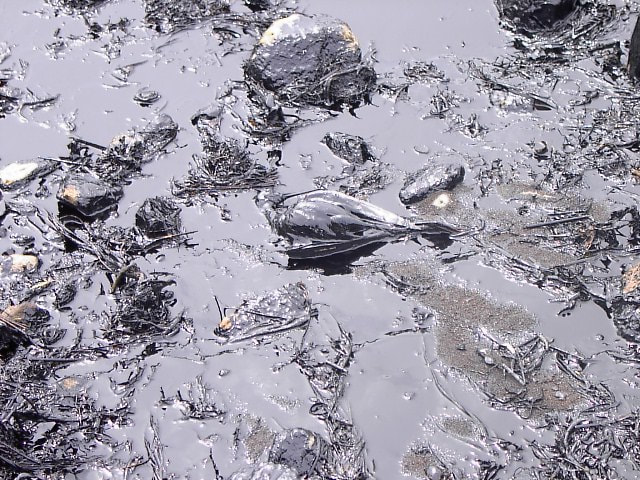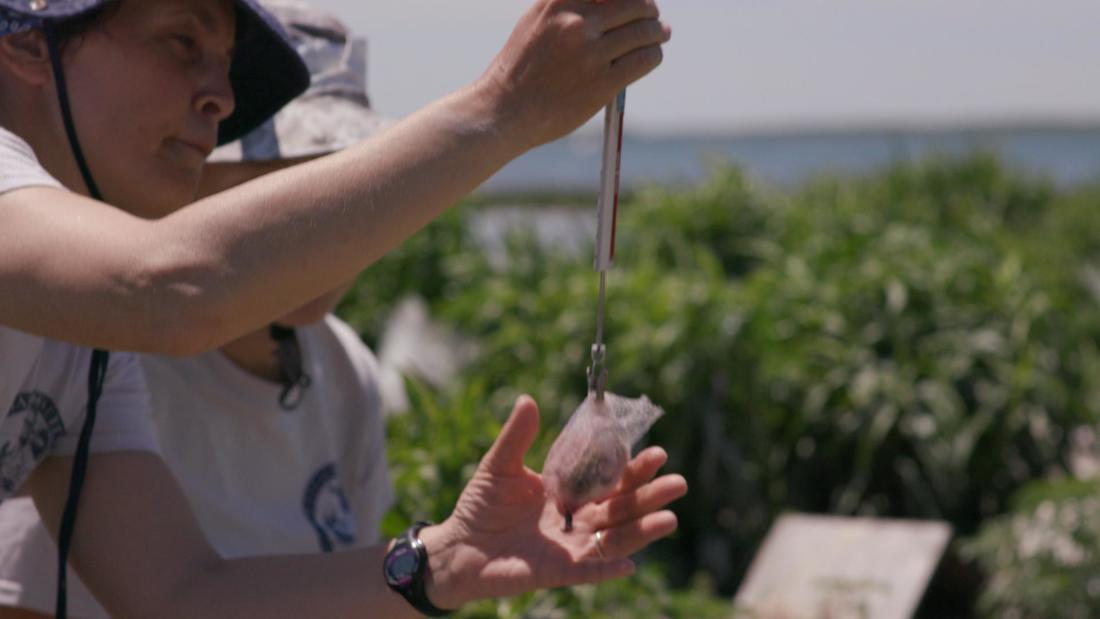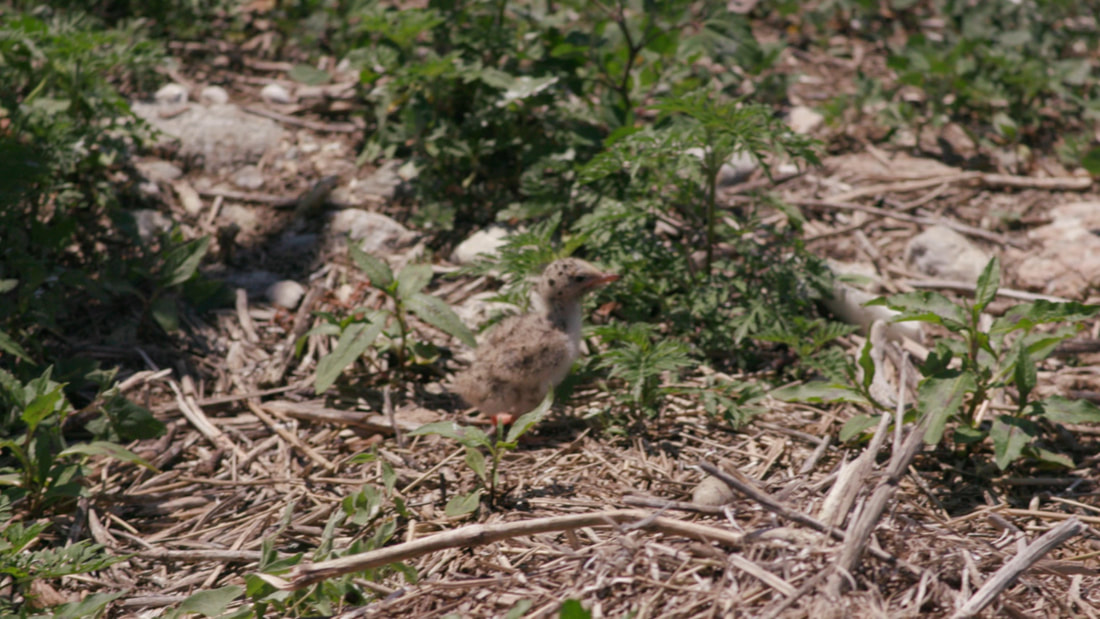|
Defending the Roseate Terns of Ram Island
By Micah Fink Near the eastern edge of the Buzzards Bay, Massachusetts, about half a mile off shore, lies Ram Island, a tiny two-acre speck of rock and sand that serves as a spring nursery for roseate terns, one of the most elegant and endangered seabirds in the Eastern United States. The island's highest point rises just nine feet above the salty waves, and as Carolyn Mostello, a veteran seabird biologist with MassWildlife, approaches in a small motor boat, a swirling cacophony of roseate and common terns, small white birds with black caps and forked tails, rises up to defend their shared nesting ground.
“Ram Island has about 1,100 pairs of roseate terns that nest on it each year,” says Mostello, who leads the Massachusetts Division of Fisheries & Wildlife’s Buzzard Bay Tern Restoration Project. "This represents about 25 to 30 percent of the total breeding population in the United States," Mostello explains, as she puts on a weathered guano-stained floppy blue hat with a foot-long stick taped to the top before landing on the island.
"The theory is that the terns will peck at the stick, instead of your head, hands and face," she says, "but it doesn’t always work." Mostello has been visiting the island for most of the last two decades, and has come to appreciate the fierce intensity of these small birds. “Even though they are pretty aggressive and sometimes you are not always happy with them, you have to admire parents that are so tenacious and go to such lengths to protect their young.” The island’s small size, she says, and the absence of trees or houses where predators can perch, combined with close proximity to waters rich with American Sand Lance, a small fish favored by the terns, makes it an idea nesting site for both roseate and common terns, which tend to nest alongside each other. While the two species look similar, the roseates have longer tails, sport at light pink coloring on their breasts during the summer season, and their beaks are mostly black during the breeding season, while the common terns are slightly larger and sport an orange bill with a black tip. “Terns, like most seabirds, nest directly on the ground,” Mostello says, pointing out speckled two small sand colored speckled eggs blending into island's rocky ground. Common terns tend to nest in the open, while roseate terns prefer to nest under vegetation or simple wooden shelters provided by their human caretakers, which is why unescorted visitors are not allowed on the island during breeding season. “The terns are only visitors here,” Mostello explains. They usually arrive in Buzzards Bay in April to breed, and then, after the chicks are hatched and fledged, they migrate in the fall to South America, with a brief stop in the Caribbean. “Some of the roseate terns go down as far as southern Brazil, while the common terns winter as far south as northern Argentina.”
A Species at Risk
Roseate terns were a popular source of hat feathers in the 19th and early 20th centuries, which caused the population to declined very sharply. The commercial trade in their feathers was eventually banned and the population rebounded. Their numbers declined again in the 1970s as gulls began to expanded their range northward, taking over many of the terns coastal nesting sites. By 1978, only 2,500 breeding pairs remained. Today, as a result of intensive management of the species and nesting grounds by scientists like Carolyn Mostello, the roseate tern has increased to nearly 4,000 breeding pairs. “These aren’t populations that are self-sustaining," she explains. “If we weren’t out here working every summer and didn’t intensively manage the island, you would again see the population decline very quickly." The problem, she says, is there are only three breeding colonies left in North America, and all are located on small low-lying islands along the North Eastern coastline. This makes these breeding grounds vulnerable to long list of potential threats, including careless human visitors, dogs, rising sea levels as a result of climate change, destructive storms, and oil spilled into the water, either intentionally by commercial vessels looking to dispose of used oil and oily waste, or as a result of industrial accidents, both of which happen far more frequently than you might imagine.
An Oiled Island
Buzzards Bay is about 8 miles wide, 28 miles long, and is a popular destination for fishing, boating, and tourism. It also serves as a major transit route for tankers and barges transporting oil and gasoline to Boston and northern New England, with nearly 2 billion gallons of oil passing through Buzzard’s Bay in 2017. More than a dozen major marine oil spills have occurred over the last sixty years, including one that took place on Sunday, April 27, 2003, just as the terns were arriving on Ram Island to mate and nest. That’s when the Bouchard 120, a squat red oil tanker passed on the wrong side of a navigational marker and hit an underwater shoal, ripping a 12-foot long tear in its hull, spilling 98,000 gallons of No. 6 bunker fuel into the bay.
“The captain didn’t realize the damage right away and the oil was dragged nearly 10 miles up the bay," recalls Mostello. "A few sites were heavily hit, including Ram Island. The birds had just begun arriving in North America, and were just beginning to nest and mate, so the timing couldn’t have been much worse.”
The thick fuel oil arrived silently in the night, she recalls, leaving a black band around the high tide line. And the following morning the bodies of oiled sea birds, including roseate terns, were found scattered along the island. “It was very sad,” she says. Nearly 100 miles of shoreline in both Massachusetts and Rhode Island were eventually coated with oil, forcing the closure of beaches and shellfish beds along the Bay. “The problem with oil, even in small amounts,” says Mostello, “is that it can compromise the waterproofing of the seabird’s feathers, leaving them vulnerable to death from hypothermia.” Seabirds spend a lot of time coating their feathers with a thick, waxy substance produced by a gland at the base of their tail, which protects their skin from direct contact with water. Oil can damage or destroy this layer of waterproofing with often lethal results. Mostello was faced with a singular challenge. How could she keep the nesting birds from further contact with the deadly oil?
The following weeks were a nightmare of frenzied activity for Mostello, who helped organize the clean up of the island.
About 2,000 terns were already roosting on Ram Island, and she feared that extended contact with the thick sticky oil could decimate the entire nesting population. There was only one solution. They had to convince the birds to leave and delay their nesting until the island could be completely cleared of oil. “Hazing is something we would never, under normal circumstances, never do,” Mostello says. But this situation was far from normal. She set up a battery of sound cannons on the island to scare the sensitive birds away during the day, and “at night we would go out with flashlight and shine lights on them,” she recalls. “The terns are very skittish at night. That would keep them off the island at night. But they would come back during the day and some of them actually nested next to the cannons while they were still firing, so it wasn’t 100 percent effective." Eventually, many of the terns moved to two other small islands in Buzzards Bay to nest. "This is why it’s so important to have multiple islands available for nesting in case of a catastrophe," which is now part of the long term conservation strategy for Buzzards Bay. “It wasn’t easy to do,” she says. “Terns can live to their mid-twenties, and the older birds are quite determined to roost at their traditional nesting sites, and it was quite hard to deter them.” The clean up was originally estimated to take one week, but it took a 40 person crew nearly four weeks to clear all the oil from the island. “The shore line is very rocky,” says Mostello, “and each and every rock was power washed and scrubbed, then flipped over and scrubbed again, because we were so concerned that the oil would continue to leach into the environment and impact our terns.” The stress of the clean up, and the removal of all the oiled seaweed, plants and marsh grasses, damaged the islands ecosystem, Mostello says, and a salt marsh at the north end of the island never fully recovered. On May 30, 2013, nearly a month after the spill, the terns were allowed to return. The U.S. Fish and Wildlife Service later estimated that at least three adult roseate terns were killed by the oil and 350 chicks were lost because of the delayed nesting, which cut the annual production of chicks by roughly ten percent. “In the short term, we definitely had reduced productivity of the birds here due to the oil,” says Mostello. “Those reduced numbers continued into the following year. Certainly, there was a harm in the year of the spill and for a few years after that.”
Assessing Oil Spill Impacts
The official clean up, recovery, assessment and compensation for the environmental damages caused by the 2003 spill is still unfolding today. In the weeks after the spill, volunteers and clean up crews found the bodies of 315 birds from 34 different species, including common and roseate terns, cormorants, willets, dunlin, great yellow legs, mute swans, common loons, and piping plovers along nearly 100 miles of coastline reaching from Massachusetts to Rhode Island. Migrating birds were also exposed to the oil, and two oiled loons were found in New Hampshire. Estimating the total effect on the roseate terns is complicated, Mostello says. “There is definitely an impact on the next generation, there are fewer birds in the next generation, and those birds killed during the spill are not able to available to produce chicks into the future." “So you have to compensate for lost productivity when you are trying to assess how much an impact an oil spill has on birds. Birds that are actually killed, birds delayed in nesting, birds that have reduced productivity because of oil effects, all of that has to be wrapped together to assess the total injury to the population. All those things are taken into account.” The spill also impacted a variety of salt marshes, rocky shorelines, recreational beaches, and local shellfish beds, some of which would remain closed to the public for more than a decade. Bouchard, the company which owned and operated the barge, agreed in 2004 to pay a $10 million dollar fine for violating the Clean Water Act and the Migratory Bird Treaty Act. The company also settled a class action lawsuit for $11.45 million filed by 700 private property owners on Buzzards Bay. The company was also liable for the costs of the cleanup and restoration of natural resources in accordance with the Oil Pollution Act of 1990, and paid out $6 million for injuries to shoreline and aquatic resources in 2010, and an additional $13 million to compensate for additional injuries to loons, sea ducks and other migratory birds and their habitat in 2017. Some of these funds, once the settlement is approved by the courts, may be used to help defend the low-lying nesting grounds on Ram Island from flooding and erosion taking place because of rising sea levels, which represents the newest threat to the species long term survival. “We just completed a big project to raise the altitude of Bird Island, another roseate tern nesting site a few miles up the Bay, to counteract the effect of sea level rise related to climate change,” says Mostello. “We have plans to do a similar project here on Ram Island to get ahead of that as much as we can. It’s expensive, but it has to be done. Climate change is here.”
By mid-June, the breeding season is already well advanced. “We got a range of chick ages on the island now,” Mostello says while lifting up the roof of a small plywood breeding box, revealing two plump young roseate tern chicks about a week-and-a-half old.
“Once they hatch it takes about three weeks for the chicks to fledge, Mostello explains. “So for the next few weeks we’ll still have chicks out here that are growing and being fed by adults, before they are ready to take off and start migration.” Once the young chicks are able to fly, they will move north in small family groups to the tip of Cape Cod to feed and prepare themselves to migrate to their winter feeding grounds in South America. The number of roseate terns in Buzzards Bay has increased by thirty-seven percent over the last eight years and Mostello is hopeful this trend will continue. “We've still got plenty of eggs that haven’t hatched but this seems to be a pretty good year for chicks,” she says, while weighing and banding a series of fluffy young birds. “Sometimes there are two chicks in the nest, and the older chick almost always does quite well. It’s the younger chick that are kind of iffy, but this year seems like a good year so far for the younger chicks and we are really pleased about that.” |
Details
AuthorMarine Defenders is an educational program designed to reduce chronic oil pollution. Archives
February 2019
Categories
All
|













 RSS Feed
RSS Feed